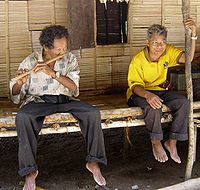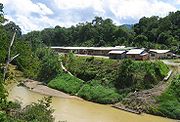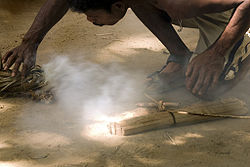
Orang Asal
Encyclopedia

Malay language
Malay is a major language of the Austronesian family. It is the official language of Malaysia , Indonesia , Brunei and Singapore...
for "Original People", and the Orang Asal along with Malays are granted Bumiputra
Bumiputra
Bumiputera or Bumiputra is a Malay term widely used in Malaysia, embracing indigenous people of the Malay Archipelago. The term comes from the Sanskrit word bhumiputra, which can be translated literally as "son of land"...
status in Malaysia.
The Orang Asal in Peninsular Malaysia
Peninsular Malaysia
Peninsular Malaysia , also known as West Malaysia , is the part of Malaysia which lies on the Malay Peninsula. Its area is . It shares a land border with Thailand in the north. To the south is the island of Singapore. Across the Strait of Malacca to the west lies the island of Sumatra...
are collectively known as the Orang Asli
Orang Asli
Orang Asli , is a generic Malaysian term used for people indigenous to Peninsular Malaysia...
, and form small minorities there. However, the Orang Asal of East Malaysia form a majority of the population.
Etymology
The term "Orang Asal" means "Original People". It was originally used by Communist insurgents in the Malayan EmergencyMalayan Emergency
The Malayan Emergency was a guerrilla war fought between Commonwealth armed forces and the Malayan National Liberation Army , the military arm of the Malayan Communist Party, from 1948 to 1960....
in order to gain the support of these tribal groups.
Status
Orang Asal are officially bumiputraBumiputra
Bumiputera or Bumiputra is a Malay term widely used in Malaysia, embracing indigenous people of the Malay Archipelago. The term comes from the Sanskrit word bhumiputra, which can be translated literally as "son of land"...
, which grants them special privileges in Malaysian society. However, their societies remain marginalized, and they have been said to be "Second class Bumiputra's." A current issue is in regards to land, which is often taken for developmental purposes. This has caused many issues, including court cases and divisions between federal and state governments. In addition, illegal logging often occurs on what is considered their traditional land. Issues have occurred in relation to immigration, where immigrants are often given identity cards ahead of the Orang Asal. In addition, many have been pressed to be assimilated into mainstream culture and convert to Islam
Islam
Islam . The most common are and . : Arabic pronunciation varies regionally. The first vowel ranges from ~~. The second vowel ranges from ~~~...
. Orang asal are often moved in response to development, the incomplete Bakun Dam in Sarawak has forced 11,000 to move.
Divisions

East Malaysia
East Malaysia, also known as Malaysian Borneo, is the part of Malaysia located on the island of Borneo. It consists of the Malaysian states of Sabah and Sarawak, and the Federal Territory of Labuan. It lies to the east from Peninsular Malaysia , which is located on the Malay Peninsula. The two are...
.
Those on the Peninsula are known more specifically as the Orang Asli
Orang Asli
Orang Asli , is a generic Malaysian term used for people indigenous to Peninsular Malaysia...
, numbering around 149,500, make up only 0.7% of the total Malaysian population. They are officially 19 ethnic subgroups, classed as either Negrito, Senoi, or Proto-Malay.
Some numbers differ, but East Malaysia contains a total of about 64 indigenous groups, around 39 in Sabah
Sabah
Sabah is one of 13 member states of Malaysia. It is located on the northern portion of the island of Borneo. It is the second largest state in the country after Sarawak, which it borders on its southwest. It also shares a border with the province of East Kalimantan of Indonesia in the south...
and 25 in Sarawak
Sarawak
Sarawak is one of two Malaysian states on the island of Borneo. Known as Bumi Kenyalang , Sarawak is situated on the north-west of the island. It is the largest state in Malaysia followed by Sabah, the second largest state located to the North- East.The administrative capital is Kuching, which...
. Orang Asal make up 60% of Sabah's population, and 50% of Sarawak's population. Sabah's population is hugely diversified, with over 50 languages and 80 dialects spoken. The largest group on Sarawak is the Iban
Iban
IBAN or Iban may refer to:People* Ibán Espadas , footballer* Iban Iriondo , bicycle racer* Iban Mayo , bicycle racer* Iban Mayoz , bicycle racer* Iban Nokan, anthropologist and ethnographer...
.
Culture

Malay language
Malay is a major language of the Austronesian family. It is the official language of Malaysia , Indonesia , Brunei and Singapore...
and English
English language
English is a West Germanic language that arose in the Anglo-Saxon kingdoms of England and spread into what was to become south-east Scotland under the influence of the Anglian medieval kingdom of Northumbria...
. The primary languages in East Malaysia are Kadazan-Dusun and Iban, both used by multiple indigenous groups. Unlike in the peninsular, these languages are commonly used in everyday life.
In the peninsular each subgroup is culturally distinct from the others, with lifestyles varying from fishermen to farmers to hunter-gatherers. Although many are now settled due to the intrusion of modern life, some remain semi-nomadic.
The population of Sabah are traditionally subsistence farmers, although nowadays they are becoming more involved in local government. Many Orang Asal in Sarawak subsist of rice, supplementing the meal with hunting. Some also remain semi-nomadic. The Orang Asal of East Malaysia are known for artwork such as their wooden masks.

